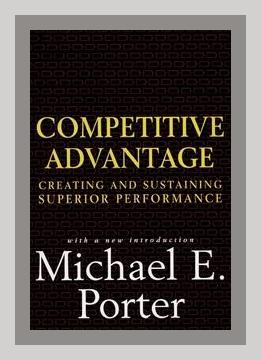Business StrategyCompetitive StrategyCorporate StrategyStrategic Planning
Title: Competitive Advantage: Creating and Sustaining Superior Performance
Author: Michael E. Porter
Year: 1985
Summary of “Competitive Advantage: Creating and Sustaining Superior Performance”
Introduction
Michael E. Porter’s seminal work, “Competitive Advantage: Creating and Sustaining Superior Performance,” builds upon his previous insights from “Competitive Strategy” and introduces the concept of value chains. Porter posits that a firm can achieve superior performance via two fundamental types of competitive advantage: cost leadership and differentiation. The text serves as a strategic tool for managers to analyze their competitive environments and develop actionable strategies for long-term success.
1. The Concept of Competitive Advantage
Porter begins by explaining competitive advantage, differentiating it from competitive positioning. The two primary forms of competitive advantage are cost leadership and differentiation.
- Cost Leadership: Gaining an edge by being the lowest-cost producer in the industry, which allows the firm to offer lower prices or enjoy higher margins.
- Differentiation: Offering unique products or services that command premium prices because of their distinctiveness.
Action: To apply this, a manager could conduct a comprehensive cost analysis of their production processes to find areas for reducing expenses, such as adopting more efficient technologies or negotiating better terms with suppliers.
Example: Southwest Airlines is highlighted for its cost leadership by implementing a single aircraft model strategy, reducing maintenance and training costs.
2. The Value Chain
According to Porter, the value chain dissects a company into its strategically relevant activities, thereby identifying sources of competitive advantage.
- Primary Activities: Inbound logistics, operations, outbound logistics, marketing and sales, and service.
- Support Activities: Firm infrastructure, human resource management, technology development, and procurement.
Action: A CEO can map out their company’s entire value chain to pinpoint areas where improvements can create more value.
Example: Dell Inc. successfully optimized its value chain by integrating suppliers into its inventory management system, eliminating the need for significant warehouse storage and thus reducing costs.
3. Cost Advantage
Porter presents numerous techniques for achieving cost advantages within the value chain. A key focus is on controlling cost drivers such as economies of scale, learning and spillovers, capacity utilization, and linkages within the value chain.
Action: Operational managers should model and compare the costs linked to various stages of their value chains and identify which ones can be minimized.
Example: Toyota’s application of just-in-time (JIT) inventory management allowed for drastically reduced storage costs and improved efficiency in product delivery.
4. Differentiation Advantage
Differentiation is achieved through two primary routes: New product innovation or enhancing the features of existing products. Porter outlines that differentiation must be valued by customers to be successful.
Action: A product development team could initiate customer focus groups to gather direct feedback that can inform product features worth differentiating on.
Example: Apple’s differentiation through design and software ecosystems enhances user experience, making its products highly desirable despite their premium pricing.
5. Technology and Competitive Advantage
Technology’s role in gaining competitive advantage is critical and pervasive across all activities of the value chain.
Action: Companies should invest in the latest industry-specific technologies to streamline processes and improve product offerings. Organizing regular reviews of emerging technologies can keep a business ahead of competitors.
Example: Amazon’s adoption of sophisticated warehouse automation and robotics has streamlined its logistics, creating a significant competitive edge in e-commerce fulfillment.
6. Competitive Scope
Porter introduces the concept of competitive scope, which can widen or narrow competitive advantage. It includes industry scope, segment scope, vertical scope, and geographic scope.
Action: Managers should evaluate their firm’s competitive scope and consider if broadening or narrowing it would unlock new opportunities. This might involve entering new markets or focusing on core competencies.
Example: Coca-Cola’s vast geographic scope allows it to leverage global operational efficiencies while tailoring its marketing to local tastes, like adapting flavors for regional markets.
7. Sustainability of Competitive Advantage
Sustaining competitive advantage involves the continuous improvement of value chain activities and staying ahead of competitors’ responses.
Action: A business could set up a continuous feedback loop where market analysis, competitor benchmarking, and internal assessments are regularly conducted to adapt strategies dynamically.
Example: Walmart remains a leading retailer by continually enhancing its supply chain efficiencies and expanding its technological capabilities to stay ahead of market trends.
8. Corporate Strategy and Competitive Advantage
Porter explores how competitive advantage is not just achieved within individual business units but also through synergies at the corporate level.
Action: Corporate strategists should frequently review the portfolio of business units to identify and cultivate synergies, possibly through mergers, acquisitions, or closer integrations.
Example: Procter & Gamble has effectively leveraged synergy among its subsidiaries, sharing research and development outcomes and innovations across various brands for competitive advantage.
9. Achieving Competitive Advantage Globally
Global competition requires persistent innovation and adaptation to local markets.
Action: A global strategy team could conduct periodic assessments to identify key regional dynamics and adjust the corporate strategy accordingly.
Example: McDonald’s adapts its menu items to local tastes and cultural preferences while maintaining core brand consistency for a diversified yet cohesive competitive advantage.
Conclusion
Porter’s “Competitive Advantage: Creating and Sustaining Superior Performance” provides a comprehensive framework for companies to analyze, enhance, and sustain competitive positions. Success in this endeavor hinges upon a deep understanding of value chains, cost management, differentiation strategies, technological advancement, scope analysis, and global market adaptation. By systematically applying these principles, firms can better navigate their competitive landscapes and secure sustained superior performance.
Final Actionable Takeaway: Regularly revisiting and rigorously analyzing all elements of the value chain, combined with a willingness to adapt and innovate, positions a company to maintain and extend its competitive advantage.
Business StrategyCompetitive StrategyCorporate StrategyStrategic Planning
